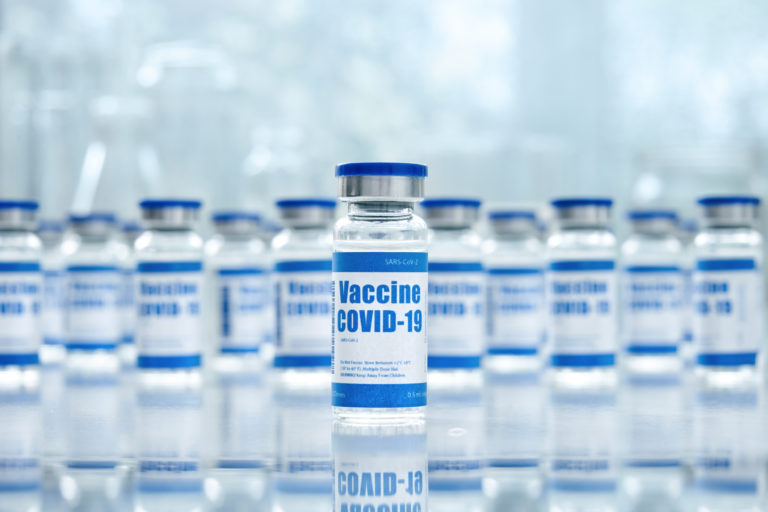With seasonal influenza, Ebola, shingles, pneumonia, human papillomavirus, and other pathogens—combined now with the novel coronavirus (SARS-CoV-2)—the world’s demand for vaccines is on a steep incline. New vaccine development is progressing rapidly, as seen with recent announcements of coronavirus options [1], [2], but what about their manufacture?
For some 70 years, vaccine production has relied on virus grown in chicken eggs. In fact, more than 80% of U.S. seasonal-flu vaccines for 2020–2021 will be produced using this traditional approach [3]. While it works, growing viral vaccines in eggs is a fairly slow process that can take weeks, requires specific pathogen-free chicken eggs, and takes up a lot of space because each egg typically only yields one dose of vaccine [4].
To overcome these limitations, researchers have turned to mammalian cells to produce the viral vaccine [5]: The cells are immersed in a nutrient medium held inside a cell-growing apparatus, known as a bioreactor, and when they reach some maximum concentration, they are infected with the viral vector, to produce a greater amount of vaccine which is then harvested and purified. Some approaches use adherent cells (cells that must attach to some surface), and some use free-floating suspension cells, but in both cases, they can produce a great deal of viral vaccine more quickly in a more controlled environment and in far less space than the traditional egg-based method.
Sticking with adherents
The cell-based production of viral vaccines that is done today is usually accomplished with adherent cells. Early iterations grew cells on the surfaces of stacked plates or flasks, but over the past five years or so, researchers have begun using microcarriers that offer far more surface area to cells and can therefore pack more cells into a similar sized bioreactor, according to Eric Vela, Ph.D., executive director for process development at Ology Bioservices, Alachua, FL, USA (Figure 1).
Ology Bioservices, for instance, has developed an approach [6] that uses a fixed-bed bioreactor developed by the company Univercells, Charleroi, Belgium. In this approach, the cells are grown on a spiral mesh fiber packed into a bioreactor, in which the growing surface remains stationary while the nutrient circulates around it to feed the cells. “This gives you a very large surface area in a very small footprint, and makes it a little bit easier to scale up within the bioreactor, instead of having to scale out,” Vela explained, noting that one of these bioreactors can produce the same amount of virus as “three, four, even ten (older) reactors working in series or in parallel.”
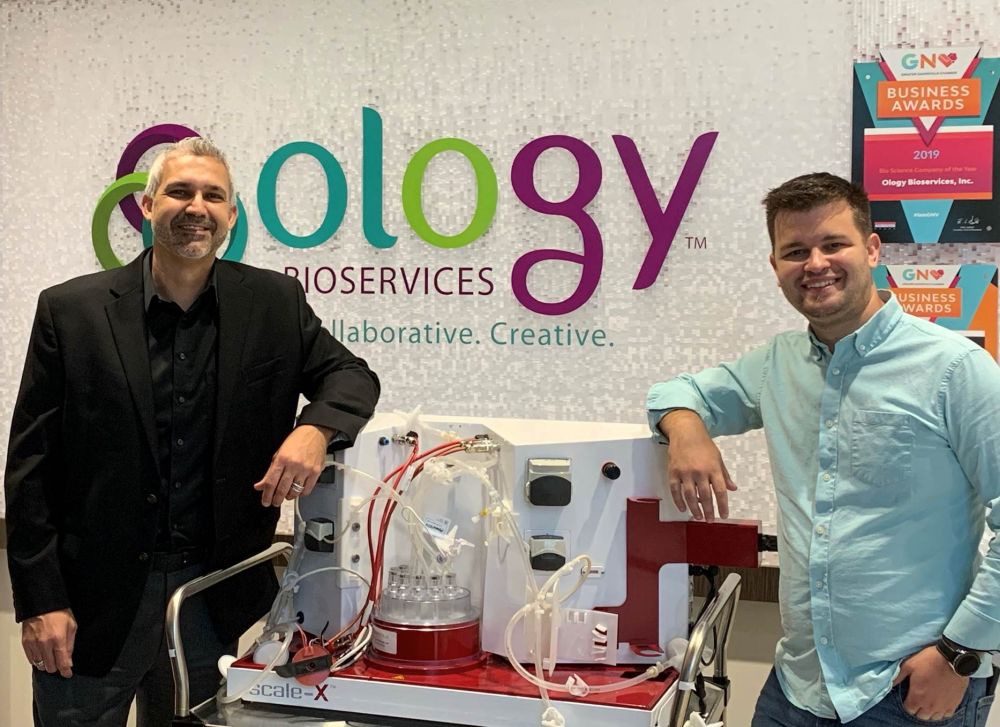
Ology Bioservices will be using the Univercells bioreactor to manufacture several viruses for vaccine production. One is Ross River virus, a mosquito-borne virus that causes acute and chronic joint and other symptoms. “This is a killed-virus vaccine, and we will be producing that in a manufacturing setting in 2021,” he said. “We’re also using these reactors to manufacture live attenuated viral vaccines for diseases such as Ebola and Marburg hemorrhagic fever, and that will be followed by three or four other programs that are very similar in scope, to produce vaccines for hemorrhagic fevers.”
This and other fixed-bed bioreactor strategies are still very new in the industry, Vela noted, so the field still has plenty of room for improvement. For instance, researchers need to ensure that the cells at these high densities get the nutrition they need to thrive. “The ‘feed’ in the media, or the nutrition, runs down very quickly, and so we are trying to understand exactly what that means and how we can supplement the media to keep our cells happy so that they can keep dividing and producing their product,” he explained.
Another consideration is the last step: purification of the produced virus. Fortunately, the Univercells bioreactor has an in-line purification process designed to minimize losses, he remarked, but Ology Bioservices is looking for ways to cut losses further. He added, “There’s still a lot in terms of science and technology to be understood to truly unleash what I would consider to be the power of the reactor.”
Bridging to suspension
One way to increase cell concentration even more is to eliminate the need for surfaces altogether, and that means switching from adherent to suspension cells, according to Yvonne Genzel, Ph.D., team leader in the bioprocess engineering group at the Max Planck Institute for Dynamics of Complex Technical Systems (MPI-DCTS), Magdeburg, Germany (Figure 2). “With cells that grow in suspension and with the development of new (nutrient) media, you can now grow these cells up to easily 10 million cells per mL, so compared to the 2 million cells per mL for adherent cells, that’s already a factor of 5 by which you could increase your productivity,” she asserted.
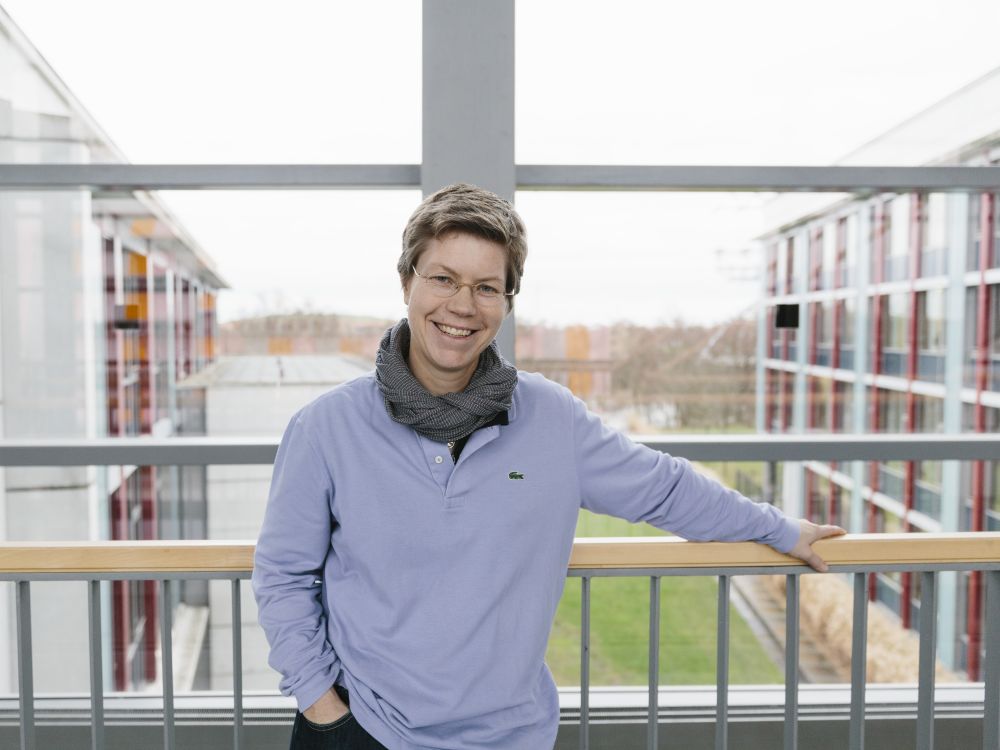
Few suspension cell lines are currently available, and fewer still have yet secured U.S. Food and Drug Administration (FDA) approval for use in vaccine manufacturing—in contrast, several adherent cell lines have such FDA approval—but Genzel’s group and others at MPI-DCTS are pressing forward with their work on a slew of new suspension-cell bioreactor models. “We’ve been focusing on using suspension cells because we think that’s what you need if you really want to improve things,” she said.
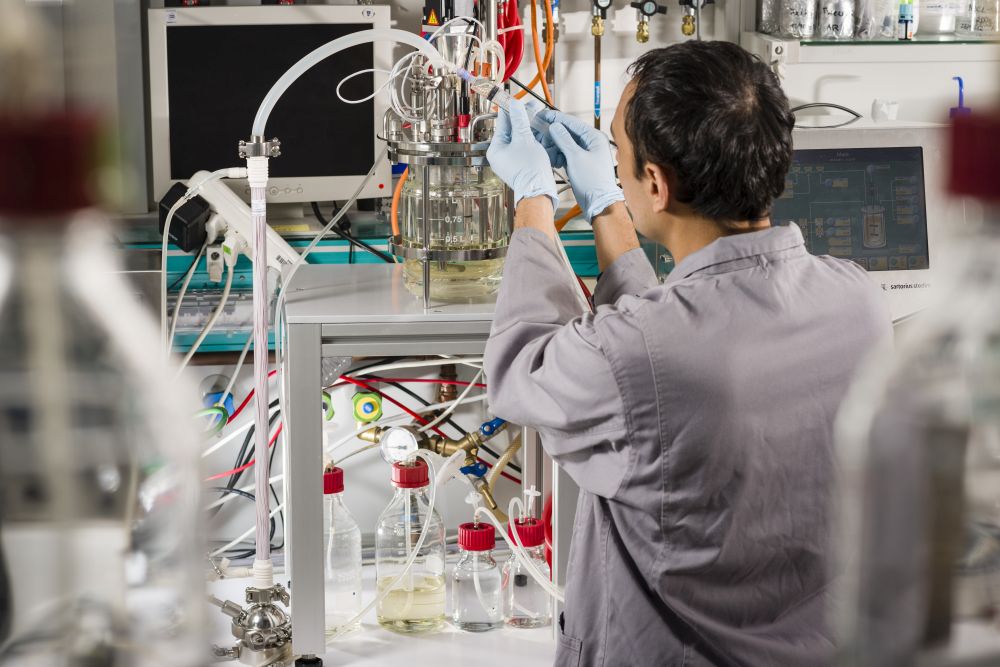
Much of their work has centered on perfusion, or ways to deliver nutrient-rich medium to the high concentration of cells in suspension, while removing nutrient-depleted medium, so they can harvest high levels of virions (Figure 3). This is made quite difficult because suspension cells are fragile and subject to rupturing and dying if placed under too much stress, Genzel explained. To that end, the MPI-DCTS researchers are looking into several bioreactor-attached perfusion devices that rely on gravity-induced sedimentation to separate the cells from the used medium, so the cells can return unscathed to the bioreactor. One example is an inclined settler, or a device constructed of a series of inclined metal plates. The medium slowly flows over the plates, gravity causes the cells to settle and accumulate at the bottom of the plates, and the cells are collected and carefully sent back into the bioreactor for continued growth.
The researchers are also using membranes to filter cells from the medium, and are especially interested in an alternating tangential flow (ATF) perfusion system [7], [8]. Here, media, virions, and cells flow into and out of hollow fibers equipped with permeable membranes, through the pores of which, nutrient-depleted medium can be removed. With the ATF system, cell growth was exceptional and reached 50 million cells per mL in the bioreactor, Genzel reported. The researchers improved the system further by employing sensors to monitor cell concentration in the bioreactor, which allowed for more precise control of nutrient demands and feeding strategies, and as a result, they were able to increase cell concentration to 160 million cells per mL in one suspension cell line. For all these runs the cells kept or even increased their cell-specific virus yield, thus higher cell concentration equaled to higher virus titers. She remarked, “Bit by bit, you can improve and improve.”
Yet another area of study is a continuous-harvest system (Figure 4), so instead of starting over every time the cells die off from the viral infection, the researchers sought a way to continually replace the dead cells with new ones so virus production never has to stop. To do it, the MPI-DCTS researchers added a secondary bioreactor designed solely to grow cells and feed the primary (infective) bioreactor. “If you could do that at high cell density, you would have the ultimate,” Genzel said.
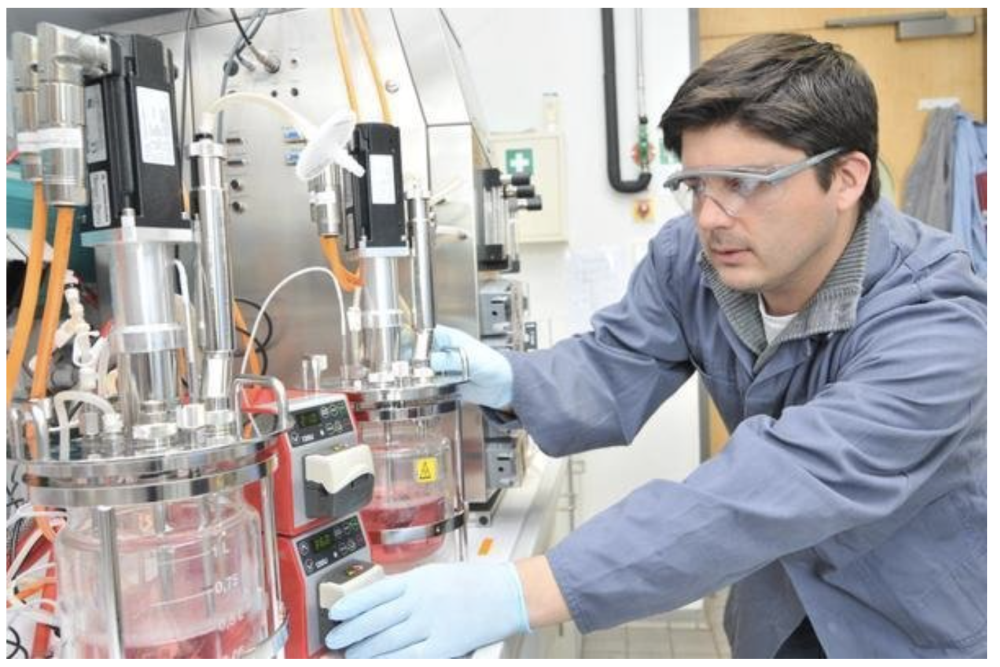
One drawback to continuous harvest is that defective interfering particles, or DIPs, can accumulate in the bioreactor. DIPs are spontaneously formed “mutant” virus particles that are unable to reproduce alone. They need a coinfection with a so-called helper virus to then push their own replication but at the same time, they interfere with the replication of the helper virus, so overall virus productivity plummets. To deal with that, MPI-DCTS doctoral student Felipe Tapia developed a continuous tubular bioreactor system (Figure 5). In this system [9], the bioreactor is a thin 100-m-long tube, and cell-containing medium is sent into the tube one small volume, or “plug,” at a time. A bit of air separates each plug, which is infected with virus individually. In this way, DIPs cannot overwhelm the entire bioreactor. A spin-off company is now developing this approach further [10].
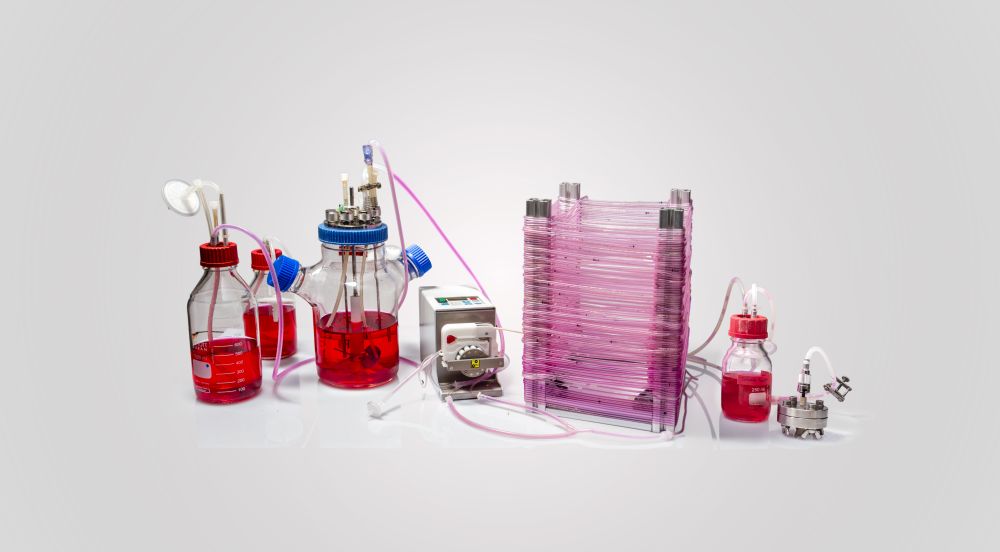
For pathogens and more
Cell-based bioreactor systems like these can make current vaccine production much faster and more economical, something that is increasingly necessary as new infectious diseases continue to emerge, remarked Vela. “A few years ago it was Zika, a few years before that it was Middle East Respiratory Syndrome (MERS), Severe Acute Respiratory Syndrome (SARS), West Nile, and Ebola, among others, and now this novel coronavirus. In a few years, something else will pop up. It seems like we’re always behind the eight ball and we have to scramble to develop a vaccine.”
New vaccine-manufacturing methods can help ensure the vaccines are available for infectious diseases, and for other uses, such as vaccines for cancer, Vela said. In fact, he noted, Ology Bioservices is heavily pursuing the production of viral-based vaccines against cancer, and will be moving into their manufacture in 2021.
Genzel is also excited about the possibility of using cell-based bioreactors for other uses. “We are now pushing into the gene-therapy and the oncolytic-virus fields (and) are currently developing a production process for a candidate oncolytic virus,” she said.
Whether for infectious diseases or cancer, these new bioreactor technologies are opening doors to the possibilities. Vela remarked, “We’re reducing the footprint, we actually don’t need that many staff to operate them, and you have more virus production. It shows the power of these bioreactors.”
References
- Pfizer, “Pfizer and BioNTech announce vaccine candidate against COVID-19 achieved success in first interim analysis from phase 3 study,” press release, Nov. 9, 2020. Accessed: Nov. 15, 2020. [Online]. Available: https://www.pfizer.com/news/press-release/press-release-detail/pfizer-and-biontech-announce-vaccine-candidate-against
- Moderna, “Moderna’s COVID-19 vaccine candidate meets its primary efficacy endpoint in the first interim analysis of the Phase 3 COVE Study,” press release, Nov. 16, 2020. Accessed: Nov. 16, 2020. [Online]. Available: https://investors.modernatx.com/node/10316/pdf
- U.S. Centers for Disease Control and Prevention, “Seasonal influenza vaccine supply for the U.S. 2020–2021 influenza season,” Oct. 15, 2020. Accessed: Nov. 16, 2020. [Online]. Available: https://www.cdc.gov/flu/prevent/vaxsupply.htm#manufacturing
- Science Channel, “The flu vaccine is made in chicken eggs,” Accessed Nov. 15, 2020. [Online]. Available: https://www.youtube.com/watch?v=krbIdBRWvLA
- A. P. Rubio and J. M. Eiros, “Cell culture-derived flu vaccine: Present and future,” Hum. Vaccin. Immunother., vol. 14, no. 8, pp. 1874–1882, Sep. 2018. Accessed: Nov. 16, 2020. [Online]. Available: https://www.ncbi.nlm.nih.gov/pmc/articles/PMC6149758/
- D. M. Berrie et al., “Development of a high-yield
live-virus vaccine production platform using a novel
fixed-bed bioreactor,” Vaccine, vol. 38, no. 20, pp. 3639–3645, Apr. 2020. Accessed: Nov. 16, 2020. [Online]. Available: https://www.sciencedirect.com/science/article/pii/S0264410X20304205?via%3Dihub - J. Coronel et al., “Application of an inclined settler for cell culture-based influenza A virus production in perfusion mode,” Front. Bioeng. Biotechnol., vol. 8, Jul. 2, 2020, Art. no. 672. Accessed: Apr. 22, 2020. [Online]. Available: https://www.frontiersin.org/articles/10.3389/fbioe.2020.00672/full
- A. Nikolay et al., “Process intensification of EB66® cell cultivations leads to high-yield yellow fever and Zika virus production,” Appl. Microbiol. Biotechnol., vol. 201, no. 20, pp. 8725–8737, Oct. 2018.
- F. Tapia et al., “Continuous influenza virus production in a tubular bioreactor system provides stable titers and avoids the ‘von Magnus effect’,” PLoS One, vol. 14, no. 11, p. e0224317, Nov. 2019.
- Max Planck Institute, “Scientists of the bioprocess engineering group receive a €1.1 million startup grant to advance gene therapy manufacturing ContiVir project will focus on the development of a continuous manufacturing platform for commercially relevant viral gene therapy vectors,” press release. Accessed: Apr. 16, 2020. [Online]. Available: https://www.mpi-magdeburg.mpg.de/3925352/2020-04-15-contivir-exist-projekt



